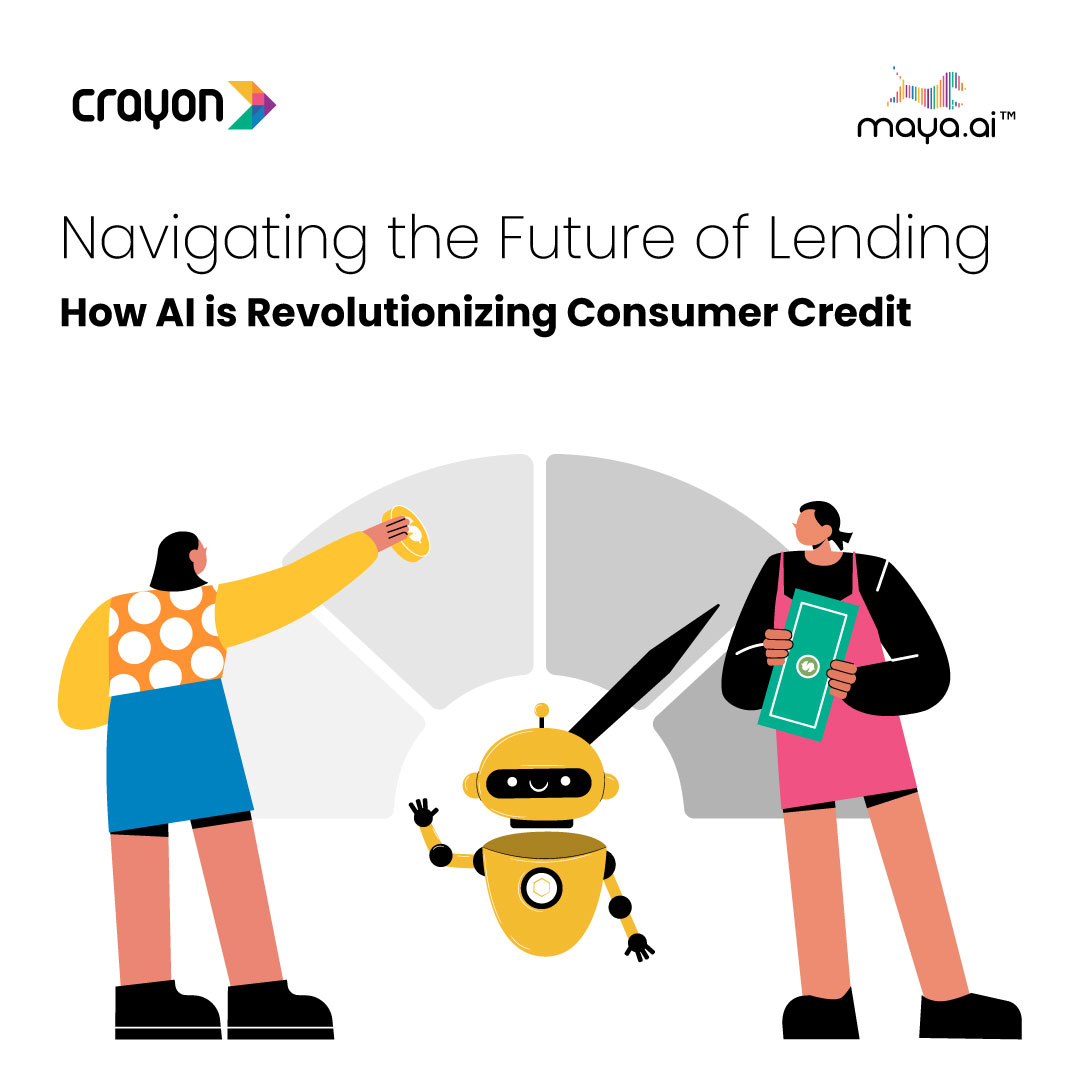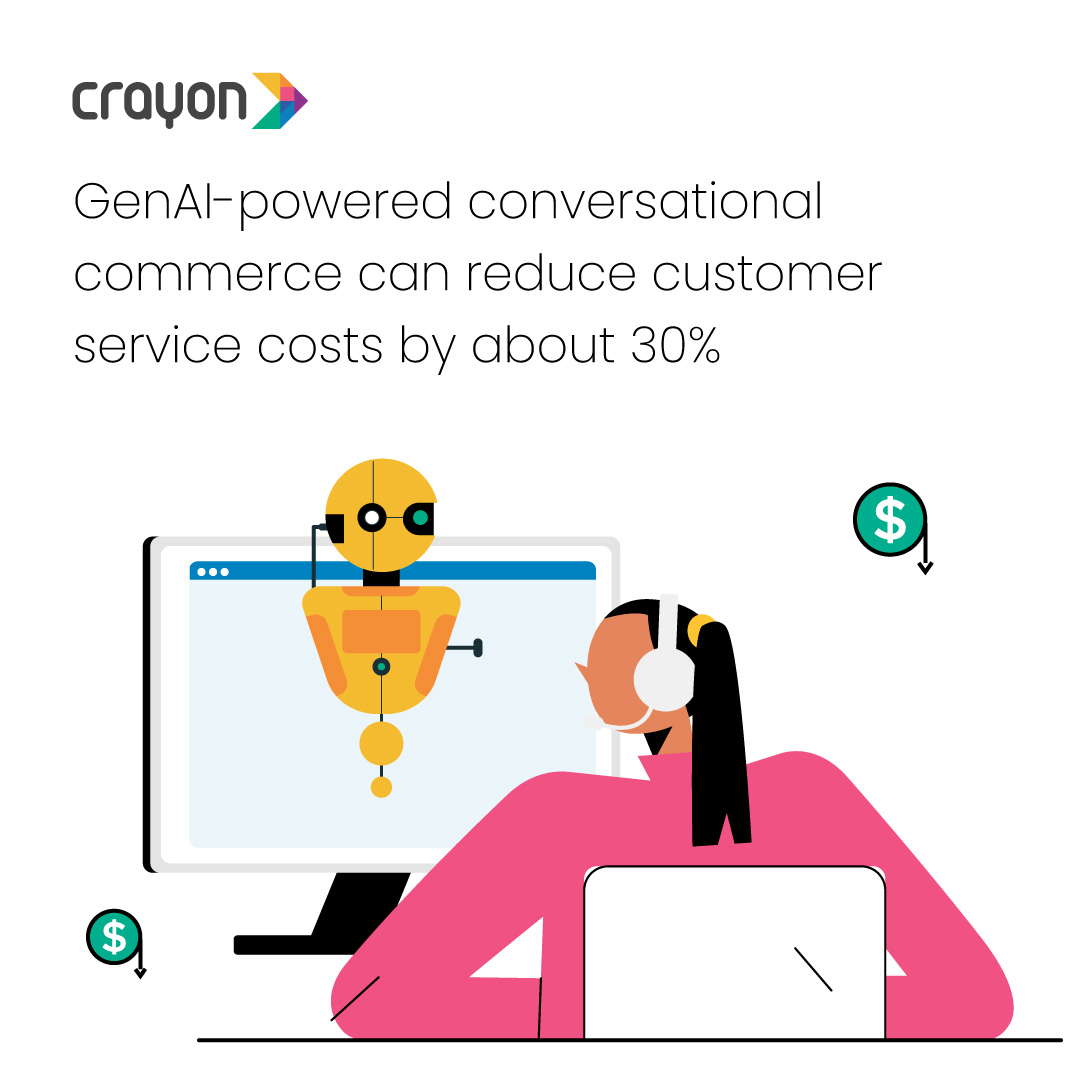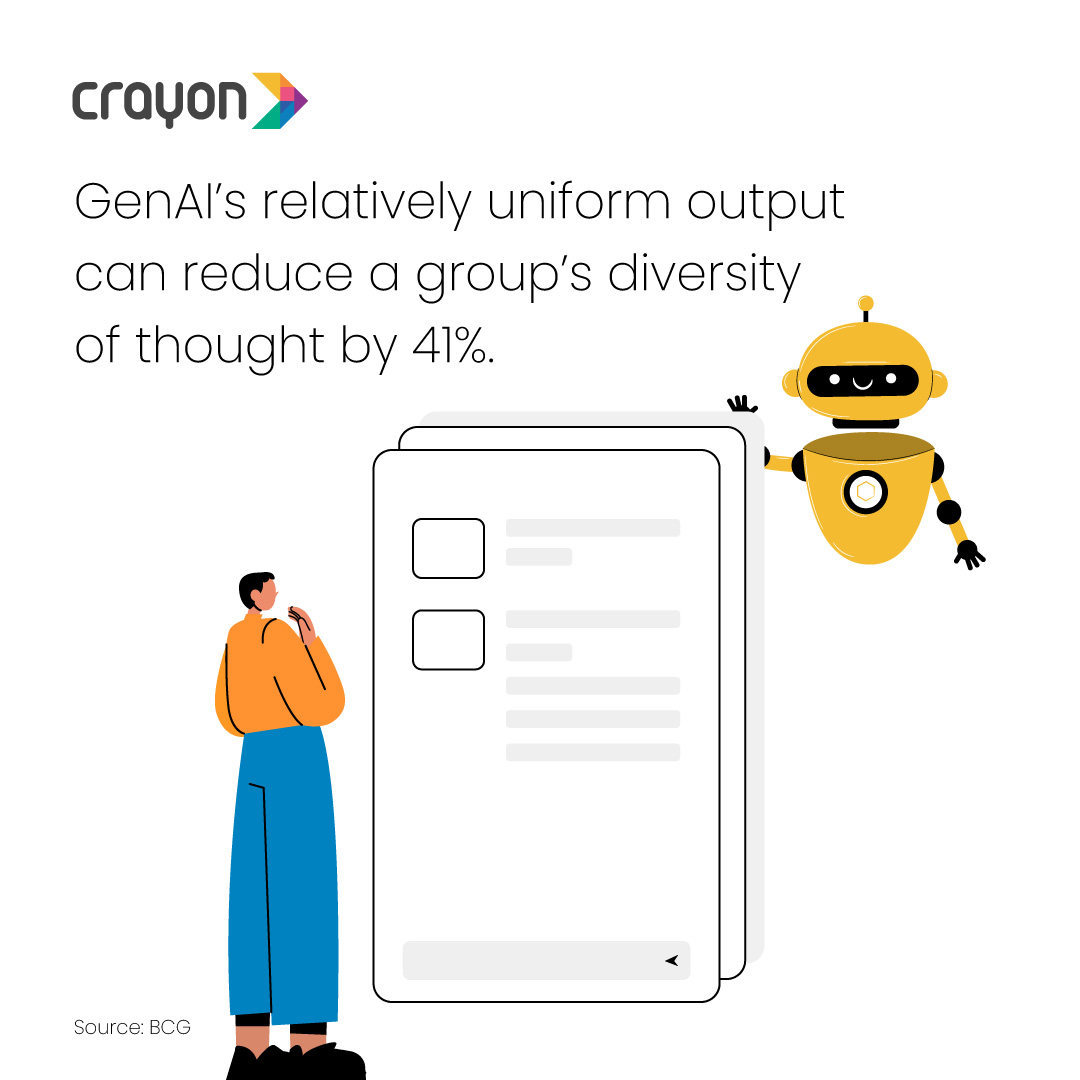
Legends of AI: Arthur Samuel
April 10, 2024
Navigating the Future of Lending: How AI is Revolutionizing Consumer Credit
May 23, 2024The Crayon Blog
Is the GenAI out of the bottle?
| Published April 16, 2024 | Sunantha Sanjeeva Rao
GenAI can be funny
Alexa, are you blue?”
Alexa: Only my light ring… Only my light ring.
Alexa: Only my light ring… Only my light ring.
GenAI can be productive
“Translate ‘Where is the restroom?’ into Spanish.
GenAI can be savage
Siri, what’s zero divided by zero?”
Siri: “Imagine that you have zero cookies and you split them evenly among zero friends. How many cookies does each person get? See? It doesn’t make sense. And Cookie Monster is sad that there are no cookies, and you are sad that you have no friends.”
Siri: “Imagine that you have zero cookies and you split them evenly among zero friends. How many cookies does each person get? See? It doesn’t make sense. And Cookie Monster is sad that there are no cookies, and you are sad that you have no friends.”
But can GenAI be an enterprise’s hidden door to more potential revenue? That’s what this blog dives into.
What is GenAI?
GenAI or Generative AI analyzes loads of existing data to create new material based on the patterns the existing data shows, without essentially repeating the data.
Applications of GenAI
Creative Pursuits
From being feared as replacements and competitors to becoming a daily use tool GenAI tools, have now secured a place for themselves in creators’ realm.
Product developments have started seeing new easier workflows since the introduction of DALL E. Works that took weeks or months, such as generating product prototypes and conceptual art, are now a matter of few iterations with the right prompts.
There are bots that can play proxy for you in virtual meetings and take notes of the meeting. So you can get the essence of the meeting without actually sitting through the meetings.
Large language models like ChatGPT and Bard have become writers’ favorite assistants. Kind of like Jarvis to Tony Stark – except that Jarvis is now everybody’s assistant.
Product developments have started seeing new easier workflows since the introduction of DALL E. Works that took weeks or months, such as generating product prototypes and conceptual art, are now a matter of few iterations with the right prompts.
There are bots that can play proxy for you in virtual meetings and take notes of the meeting. So you can get the essence of the meeting without actually sitting through the meetings.
Large language models like ChatGPT and Bard have become writers’ favorite assistants. Kind of like Jarvis to Tony Stark – except that Jarvis is now everybody’s assistant.
Customer Experience
A recent Garter poll involving 2500+ executives suggests that 38% voted for customer experience as their primary purpose of GenAI investments. But how can tools like ChatGPT improve customer experience? Here’s how:
1. Speak volume
GenAI can help enterprises enable personalization at scale, and carry out other process changes for large volumes. With content creation timelines getting shorter, BCG (Boston Consulting Group) predicts that a normal campaign creation that takes 3 months today shall be wrapped up in 1-2 hours in the future, if GenAI is embedded across the campaign creation process.
2. Customer self-assist
No, we’re not talking about the chatbots that run on predefined scripts and choosing between given options. We’re talking like GenAI integrated bots that can make it look like you’re talking to a customer representative, but on text. Word around the AI town is that it these new-gen bots can give rise to something termed ‘conversational commerce’. Such bots can facilitate self-assistance with minimal human intervention. In a recent BCG survey of 500 US consumers, 66% expressed strong interest in trying GenAI-powered conversational commerce.

Risk management and compliance
Processing and analyzing large amounts of data makes GenAI a valuable asset to the field of risk management and compliance. Here are the key areas GenAI could make a drastic magic:
1. Risk identification
Exposure to and analysis of large amounts of data helps in the deciphering of abnormal patterns or anomalies. Let’s say the platform identifies a potential disruption in the supply chain. This information would be helpful to risk managers and help them have a contingency plan in place.
2. Holistic analysis
GenAI could be a risk manager’s best colleague. The GenAI platform in question has a thorough understanding and knowledge of the company’s data, which makes it an invaluable partner to brainstorming workflow plans or changes. This could help highlight mistakes or areas to improve, which may have escaped human judgment.
3. Enhanced compliance
By integrating a GenAI platform in the workflow, one can enable a step-by-step verification of a process with a set framework or regulation.
4. Simplification of jargon
No more clicking ‘I agree to the terms and conditions without’ knowing the implications. GenAI can scan through the legalese to find out unfavorable obligations or exchanges that may lie buried deep inside legal jargon.
For example, PwC has developed a solution that scans through the documental prose and translates them into actionable insights. As per PwC, by extracting and generating critical compliance elements such as obligations, control statements and risk statements directly from complex regulatory texts, the solution maps these extracted obligations to the client’s existing policy documents. It also produces a set of tasks the client’s compliance officer can follow.
For example, PwC has developed a solution that scans through the documental prose and translates them into actionable insights. As per PwC, by extracting and generating critical compliance elements such as obligations, control statements and risk statements directly from complex regulatory texts, the solution maps these extracted obligations to the client’s existing policy documents. It also produces a set of tasks the client’s compliance officer can follow.
The AI Paradox
BCG conducted an experiment to test the efficiency of GenAI in the official context, with 750 BCG consultants as subjects. For the purpose of experiment, the subjects were made to use ChatGPT-4 in their professional setting. The results of the experiment revealed a paradoxical situation.
When used for ideation and content creation:
- 90% of the participants who used GPT-4 improved their performance
- The performance of those that used GPT-4 was 40% higher than that of those working on the same task without GPT-4. This betterment was well-captured when they did not attempt to improve the output that the technology generated
When used for business problem-solving:
- Those who used GPT-4 performed 23% worse than those doing the task without GPT-4
- Even subjects who were warned about the possibility of wrong answers from the tool did not challenge its output
Overall impressions:
- The lower the individual’s baseline proficiency, the more significant the effect tended to be
- The negative effects of GPT-4 on the business problem-solving task remained the same even when subjects were given an overview of how to prompt GPT-4 and of the technology’s limitations
- In fact, those who were given the overview of prompting and the limitations of the technology performed worse than those who did not
- When the participants were interviewed, 70% said that extensive use of GPT-4 may stifle their creative abilities over time
Of course, these are just the results of one group in a similar job set up. But nonetheless, the results are interesting. The efficiency of GPT-4 is more pronounced in creative tasks than in business problem-solving tasks.
With time and tools, GenAI may grow to prove their mettle in the administration and management part. Till then it is only safe that we use it in creative pursuits and even then, verify their correctness.
With time and tools, GenAI may grow to prove their mettle in the administration and management part. Till then it is only safe that we use it in creative pursuits and even then, verify their correctness.
Why go GenAI?
Enhanced efficiency
By directing mundane and repetitive tasks or tasks that need minimal human intervention, the time to the end result is cut short significantly, thus increasing efficiency.
Explore, explore, explore
Artists and creative personnel can explore different styles and experiment their heart out.
Ever-evolving platforms
GenAI platforms not only generate results, they learn preferences to give a better personalized result to the user.
With such advantages why is GenAI still being used so marginally? Here are the why-nots.
Why-nots
Lack of regulations
Deepfakes and their realness have certainly sown a tendency in us to disbelieve any image put in front of us. With public access and the skill to use it anyone can doctor or fabricate anything.
In the absence of a regulatory framework, GenAI is a goldmine for those with harmful intent. The day when media files may become unacceptable forms of evidence is not far away.
And then there’s the issue of intellectual property and copyrights too. Facts fed confidentially have a possibility of getting exposed to the public. With such hurdles, it is only right that GenAI is used for preliminary purposes in the official contexts.
In the absence of a regulatory framework, GenAI is a goldmine for those with harmful intent. The day when media files may become unacceptable forms of evidence is not far away.
And then there’s the issue of intellectual property and copyrights too. Facts fed confidentially have a possibility of getting exposed to the public. With such hurdles, it is only right that GenAI is used for preliminary purposes in the official contexts.
Decreased diversity
Delve, certainly, captivating, moreover, additionally, in conclusion, furthermore, on the other hand.
What are these?
These words, according to Gary Vaynerchuk – an author, speaker, and internet personality – are the words that could indicate your content was written by AI. Overuse of such impact words by GenAI have brought a predictable tone to the content. If mass content is generated using AI, there’s the risk of seeing the same stuff in more than one place.

Unpredictable output
In quite a few instances, AIs output seemed to have a bizarre or no rationale behind it. Even the companies that develop them aren’t always able to explain or map the rationale that led to the output.
2023 was the year.
2023 was the year.
Roberto Mata, claimed that he was “struck by a metal serving cart” onboard a 2019 flight and that such incident caused him to suffer personal injuries.
While preparing the response, Mata’s lawyers cited 6 other cases as precedents. But the court found those cases to be non-existent and dismissed them as bogus. Steven Schwartz, a member of the lawyer team then admitted to using ChatGPT for legal research.
What went wrong? Most people think of platforms like ChatGPT as search engines, which they’re not. The thought process behind it – ‘I type in a question and it gives me answers. Isn’t that all there is to it?’ This lack of understanding on the difference between generative tool and search engines is what led to such a mishap.
While preparing the response, Mata’s lawyers cited 6 other cases as precedents. But the court found those cases to be non-existent and dismissed them as bogus. Steven Schwartz, a member of the lawyer team then admitted to using ChatGPT for legal research.
What went wrong? Most people think of platforms like ChatGPT as search engines, which they’re not. The thought process behind it – ‘I type in a question and it gives me answers. Isn’t that all there is to it?’ This lack of understanding on the difference between generative tool and search engines is what led to such a mishap.
Bias
Ultimately, AIs gather their data from humans. Therefore, it may also learn biases that seep into the data.
Dr. Joy Buolamwini , a graduate researcher at the Massachusetts, and the founder of Algorithmic Justice League realized this algorithmic bias while creating the Aspire Mirror . The device allows users to see their reflection projected with something that inspires them, or something they empathize with. However, the program could not detect her face even after numerous debug attempts.
Dr. Joy Buolamwini , a graduate researcher at the Massachusetts, and the founder of Algorithmic Justice League realized this algorithmic bias while creating the Aspire Mirror . The device allows users to see their reflection projected with something that inspires them, or something they empathize with. However, the program could not detect her face even after numerous debug attempts.

Joy decided to take things into her own hands. Literally. She drew a face on her palm. The program detected it instantly. Next, she did something she felt conflicted about. She wore a plain, white-colored mask lying in her office. Again, the recognition was instantaneous. This prompted her to dig further into the benchmarks used for facial recognition. Here’s what she gathered:
1. One of the leading gold standards, named “Faces in the Wild” was composed of 70% male and 80% white.
2. Heavily skewed data sets caused by the use of celebrities’ looks as standards. The faces of the rest of the world do not necessarily have to align with this ‘standard’.
2. Heavily skewed data sets caused by the use of celebrities’ looks as standards. The faces of the rest of the world do not necessarily have to align with this ‘standard’.
Joy started to see something she calls “power shadows” — when either the inequalities or imbalances that we have in the world become embedded in our data. This is just the findings of one person. Imagine this on a global scale.
Sustainability
The less-spoken side of the AI revolution – what does it cost environmentally to keep such platforms running. These platforms run on data, which is served in servers in data centers. Such centers are power-hungry and also generate substantial carbon footprint. Here are some numbers on the consumption patterns of GenAI:
- It is estimated that ChatGPT emits 8.4 tons of carbon dioxide per year, which is twice as that emitted by an individual– which is 4 tons per year.
- A report suggests that Microsoft used approximately 700,000 liters of freshwater during GPT-3’s training in its data centers
But it is also worth noting that these concerns are driving quicker implementation of renewable sources of energy. As of 2021, Google’s data centers sourced 50% of its power requirements from renewable sources, and is steadfastly looking to up it to 100% by 2030.
All in all, GenAI in business looks like a win-win in the initial levels only. Moving up the ladder, the decisions are much more complex and sensitive to be handed to something that is non-sentient.
Sure, things may develop, and AI may be trained enough to be a part of management. But we can’t help but think of it as a gamble. And rolling the dice on an algorithm making decisions for people isn’t in the purview of responsible leaders.
All in all, GenAI in business looks like a win-win in the initial levels only. Moving up the ladder, the decisions are much more complex and sensitive to be handed to something that is non-sentient.
Sure, things may develop, and AI may be trained enough to be a part of management. But we can’t help but think of it as a gamble. And rolling the dice on an algorithm making decisions for people isn’t in the purview of responsible leaders.
Recent Blogs
Subscribe to the Crayon Blog. Get the latest posts in your inbox!



